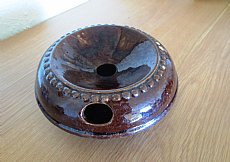Skibo A Canadian Forestry Camp
02 November 2020
- News Type:
- Site of the Month
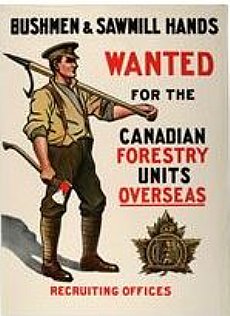 The Canadian Forestry Company was active in the Highlands during World War I and World War II, bringing not only lumberjacks to the Highlands but also shipping over their own sawmills, believing the traditional ‘Scotch mill’ to be inferior. Wood was needed in wartime, in part for pitprops for mines, but in WWI, also for shoring of trenches in WWI (Bird and Davies 1919; Wonders 1991).
The Canadian Forestry Company was active in the Highlands during World War I and World War II, bringing not only lumberjacks to the Highlands but also shipping over their own sawmills, believing the traditional ‘Scotch mill’ to be inferior. Wood was needed in wartime, in part for pitprops for mines, but in WWI, also for shoring of trenches in WWI (Bird and Davies 1919; Wonders 1991).
The remains of these forestry camps tend to be ephemeral, as most buildings were constructed of wood. However, in the case of a camp near Loch Migdale in Sutherland it has been possible to link documentary evidence, oral history and remains on the ground to reconstruct one sawmill and camp. This work emerged from memories collected as part of the Woodland Trust’s Ledmore and Migdale Wood project.
There were three camps in the area, Skibo A at the eastern end of Loch Migdale, Skibo B on the Achue Road, and Skibo C at Clashmore. Each site had a hall where dances were held, attended by Canadians and locals Documentary sources provides information on the units stationed at these camps and their output (Wonders 1991). Local memories identified the sites of the accommodation and the sawmill at Skibo A.
 At the accommodation area, near the end of the loch, no buildings survive, but there are platforms where wooden structures were probably located. The only remains are septic pits.
At the accommodation area, near the end of the loch, no buildings survive, but there are platforms where wooden structures were probably located. The only remains are septic pits.
The area further down the path towards Spinningdale where the sawmill was located is currently (October 2020) an activity area for the Woodland Trust. There remains of the operation were investigated by two community groups, ARCH and NoSAS. Memories by Hamish Matheson of the similar sawmill at Skibo B gave an indication of what to look for on the ground.
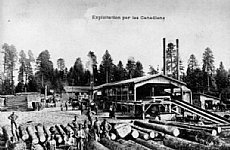 Logs were hauled to the area from forests around. A lade from a small burn was constructed to create a pond; the dam on the burn can still be traced, as well as remains of shoring where the pond was located. Remains of a timber bridge can be discerned where the lorries crossed to get to the pond. From the end of the pond is a small slope where logs were hauled up towards the sawmill. The concrete base of the mill is under moss and turf; its foundation is difficult to interpret, although someone with specialist knowledge might be able to shed light on this. The mill is likely to have been multiple storey and built of wood, as shown by photos of Canadian mills elsewhere.
Logs were hauled to the area from forests around. A lade from a small burn was constructed to create a pond; the dam on the burn can still be traced, as well as remains of shoring where the pond was located. Remains of a timber bridge can be discerned where the lorries crossed to get to the pond. From the end of the pond is a small slope where logs were hauled up towards the sawmill. The concrete base of the mill is under moss and turf; its foundation is difficult to interpret, although someone with specialist knowledge might be able to shed light on this. The mill is likely to have been multiple storey and built of wood, as shown by photos of Canadian mills elsewhere. 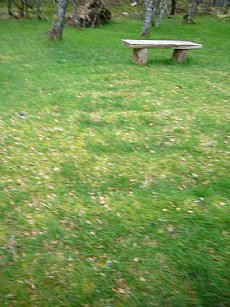
Near the mill are lines of undulating turf which are remains of a large number of railway sidings, clearly visible on a 1946 aerial photograph, along with huge mounds of sawdust. The cut timber would have been moved around the site on bogies, until placed on lorries at a loading site which can also be identified on the ground, and then transported by road, probably to the railway at Dornoch or Ardgay. 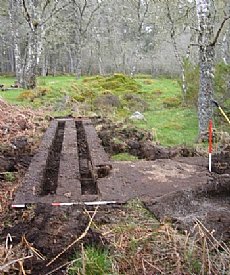
The concrete foundation of a square building is visible near the area where timber was exported; this may be a guard hut. Other possible foundations could be discerned for other buildings. The sawmill is likely to have had a canteen area (unless workers used one in the camp near the loch), shelter for rain, storehouses, perhaps latrines and a small smithy. Two middens also survived, added to after the camp was deserted, yielding a range of bottles, ironwork and a spittoon.
The site is important in providing an idea of the layout of a typical camp, to aid identification of sites elsewhere. It also shows the value of combining memories with documentary evidence and physical remains. Although only investigated in 2015, some key informants have unfortunately passed away. Memories of other CFC sites (and indeed World War II remains) should be collected as a matter of priority.
Further information
Ledmore and Migdale Memories (available from ARCH website Library in the ARCH Project Reports folder)
Bird, C W and Davies, J B 1919 The Canadian Forestry Corps. Its inception, development and achievements, HMSO: London.
Wonders, William C 1991 The ‘Sawdust Fusiliers’: the impact of Canadian Forestry Corps in the Scottish Highlands in World War II, Canadian Pulp and Paper Association: Montreal.
Site of the Month Archive
- 10/04/2021 Easter Raitts township
- 02/03/2021 Lower Slackbuie, Inverness (ASDA) Neolithic site
- 01/02/2021 Balnuaran of Clava cairns
- 04/01/2021 Wilkhouse Inn
- 02/12/2020 Spinningdale Cotton Mill
- 02/11/2020 Skibo A Canadian Forestry Camp
- 01/10/2020 WWI Detonator Store, Dalmore near Invergordon
- 03/09/2020 Mesolithic Shell Midden at Sand, Wester Ross
- 08/08/2020 Kinbeachie Neolithic settlement
- 01/07/2020 Armadale Cist Burial and Stone & Timber Complex


